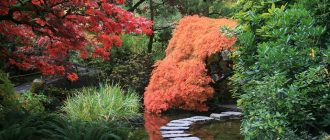 Japanese garden edging comes in a variety of styles, types and serves different purposes. To find out more, read our guide for facts & information…
Japanese garden edging comes in a variety of styles, types and serves different purposes. To find out more, read our guide for facts & information…
Japanese gardens
Japanese gardens are works of art, not to mention their carved water basins, garden benches and other various elements that make up the garden.
There is one important element that makes it look crisp and clean and flow nicely. Edging works well in any garden, but in a Japanese garden a properly placed edging and what it is made out of will make all the difference to the garden itself.
Other reasons to have a nice edging in your garden are:
- Borderline – helps to give a border between the garden and everything else and helps give your garden paths a border as well.
- Center of attraction – you can make one spot in the garden the center of attraction with a different edging than the rest.
- Ornament – edging makes things looks elegant, like an ornament of sorts.
Different Types of Japanese Garden Edging
There are all different kinds of edging from bamboo to stone and each has its advantages and disadvantages. Edging stones range in different materials from slate to river rock and cast stone. Each has their own advantages and uses.
- Slate – reliable substitute for landscaping comes in cloudy shadow colors and will create clean lines in your garden.
- Terracotta – for tiny color and patterns this works well. One of the top edging rocks because of its shade of color.
- Stone – can be used many different ways, such as edging a greenhouse, a pool or a waterfall.
- Gravel – can be used as pathway and border ways.
- Brick – has been broadly adopted recently as a border. They don’t have to be laid out in the traditional manner. They can be laid in all sorts of ways to make things look interesting to you.
- Decorated concrete – best tough edging is concrete and can be molded into anything for any kind of look.
- River Rock – gives a natural look and feel to any garden.
- Cast Stone – is an artificial copy of rock that can be utilized as an alternate for natural rock.
Other types of edging are:
- Bamboo – the cut cane of bamboo, cut to the desired height and buried in the ground makes a very intricate edging.
- Iron fence – depending on their design can add a bit of elegance to your Japanese garden.
No matter what edging you go for in your Japanese garden, it needs to have a pleasing aesthetic look. Natural flow into the rest of the garden is the main goal. Remember, Japanese gardens are known for their peace and tranquillity. The colour of the edging needs to match and follow the natural flow of the garden.
Don’t place similar sized rocks together. You wouldn’t see that in nature. They are all different sizes grouped together. Nature is the key to a great Japanese garden and the key to great edging as well.




